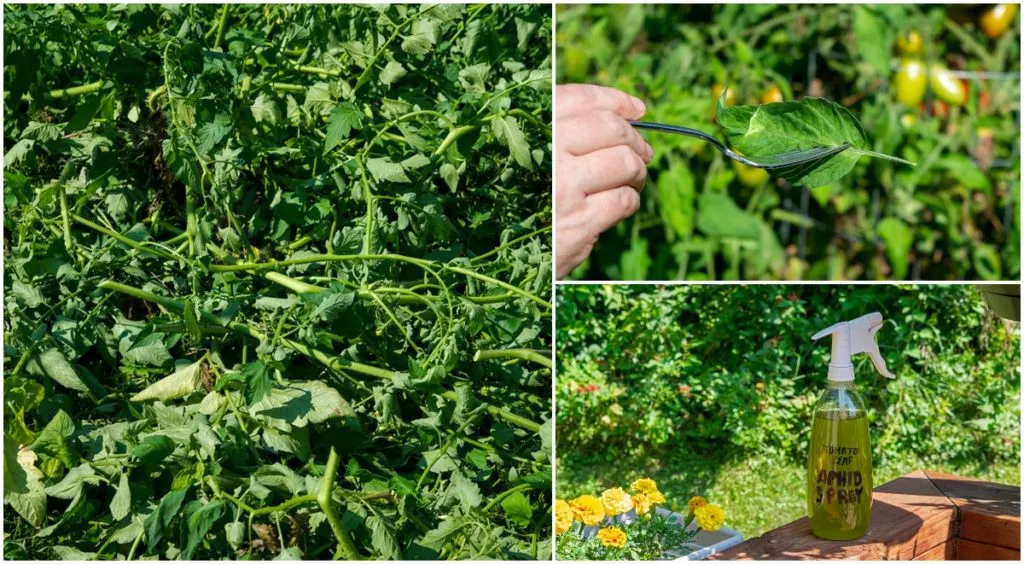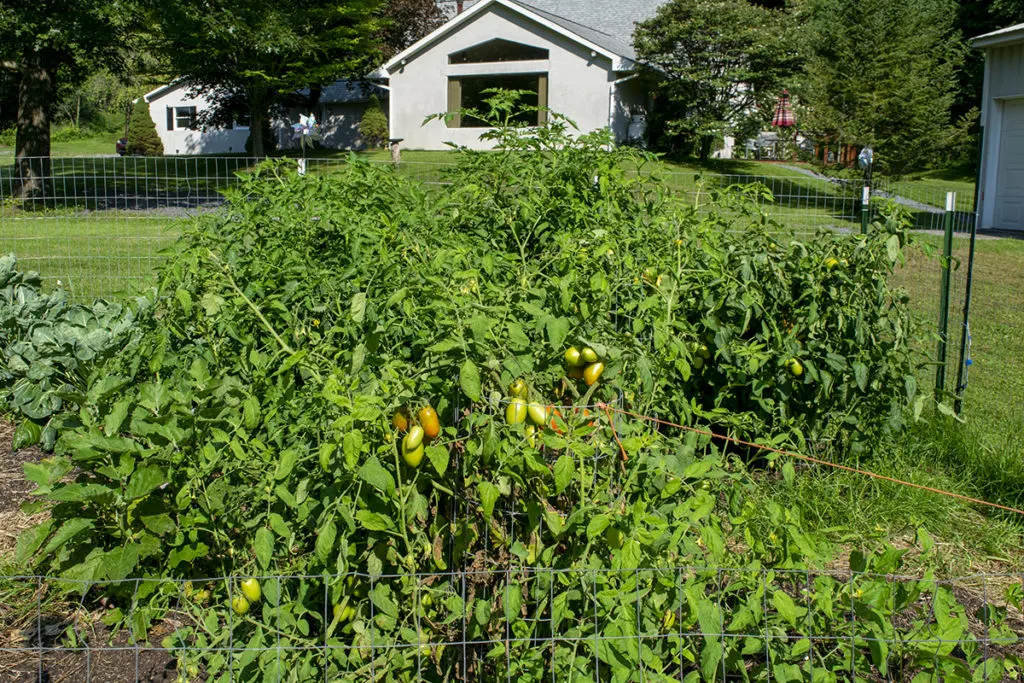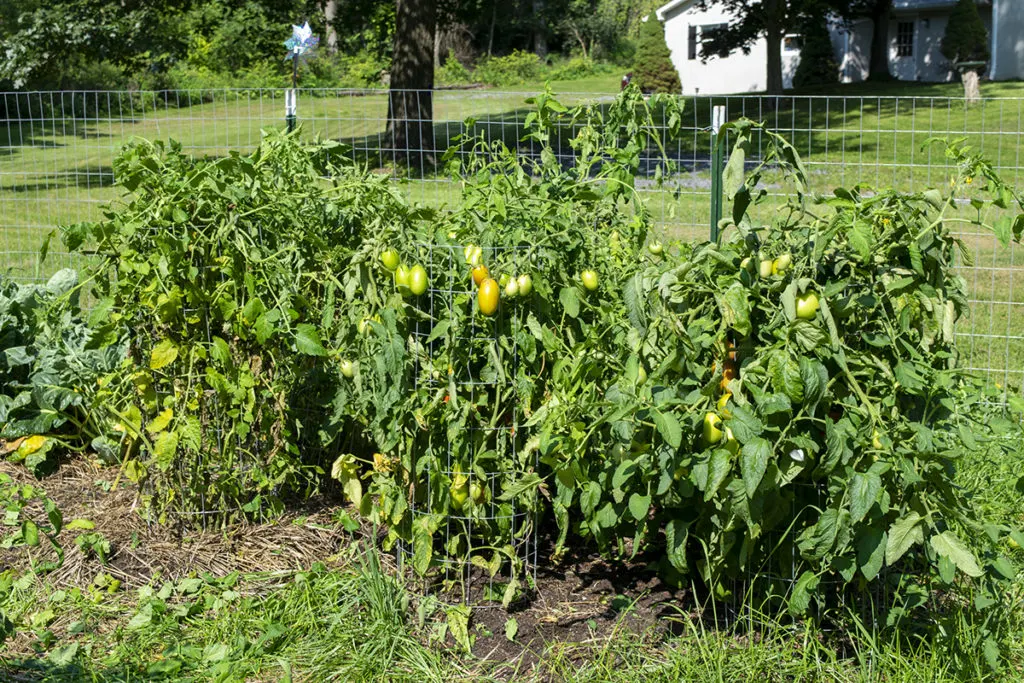
I want you to take a moment to peek out the window at your garden. Specifically, look at your tomatoes.
If it’s late summer, you’re probably wondering when your tomato plants took over your garden.
It’s funny, isn’t it?
We put so much effort into getting the silly things to grow and start producing in the spring. And the next thing you know, your Romas have encroached on every plant within a five-foot radius. You can’t find the path to get past the tomatoes. And you distinctly remember planting marigolds near the base of the pineapple tomato, but they’re nowhere in sight.

When it comes to garden pruning, we most often think about fruit trees. However, plenty of vegetables benefit from a haircut once or twice throughout the growing season.
And tomatoes are definitely one of those vegetables.
Let’s take a look at why it’s important to prune your tomatoes in the late summer. And at the end of this article, I have a shocking tip for you.
Hint – it involves using the tomato leaves you’re going to be pruning off in a way you never thought possible.
Most tomatoes are indeterminate, meaning they will keep growing and putting out fruit until they’re hit with a frost, which is great if you live in an area with long, hot summers. Hi, Florida friends!
However, if you live in an area where winter does indeed show up, you want your tomato plants to be putting all of their energy into ripening fruit for a final fall harvest. You don’t want them growing more vines for the eventual fruit you know will never ripen before your first frost.
This is why it’s important to give your tomatoes a hard, late summer prune.

Of course, if you’ve planted determinate varieties, none of this will help. You get to sit back with your ice-cold lemonade and watch the rest of us work up a sweat.
For late summer tomato pruning, I find it best to do two separate trimmings.
First Trim
The purpose of the first trimming is to go in and clean house. Grab your garden pruners and a pair of gloves and prepare to get sweaty.

This first pruning is when you’ll reshape the plants and add airflow and light back into the entire bush.
The idea is to reign in your wild creeping vines and open up the center of the plant, allowing better airflow and sunshine to permeate. Don’t cut out central stems, but everything you snip beyond that is personal preference.
The best rule of thumb is this – no flowers or fruit – cut it off!
You can cut it back hard if you know winter is coming soon and you want the tomatoes already on the vines to ripen. Or you can bring order to chaos and encourage the current flowers to set fruit for a late fall harvest.
At the very least, you’ll want to:
- Trim out the dead leaves toward the bottom of the plant.
- Cut off stems that have died off from pests or disease.
- Trim off stems that have snapped under their weight.
- Tie up any stems that are growing on the ground.
- Take the time to stake heavy stems that have grown during the summer and now need support.
- Re-stake vines that have begun to lean because of their weight.
- Finish by giving your plant a drink if it needs it.

To make pruning easier, open your tomato cage so you can access the plant’s interior more easily. Staking is easier this way as well. It’s a bit like loosening your belt after Thanksgiving dinner.
An Argument Against Traditional Tomato Cages
If you’ve used a traditional tomato cage, you’re probably thinking that this last step is impossible. And you’d be right. This is why I don’t use them for my tomatoes anymore, and neither should you.
Every spring, we see towers of metal tomato cages in every garden center and hardware store.

For many a gardener, this is what they use every year, without fail. However, I find them to be a poor choice.
You have to put them over the tomato early or risk breaking tender stems as the plant develops. They rarely stay put, often toppling over once the tomato plant fills out and is heavy with fruit.
If you want to find every blasted rock in your garden, try putting a tomato cage over a tomato plant.
Then, picking ripe fruit from the interior becomes a chore because the tomato is caged in this circle. Not to mention the stems of the interior of the plant become crowded. If they become too crowded, the leaves may not dry well when it rains, and you risk opening up your plant to disease, such as blight.
What’s your alternative?
Oh gosh, dear reader, I’ve got 38 alternatives for you.
38 Tomato Support Ideas for High Yielding Tomato Plants
But don’t throw out those old traditional cages; you can use them for other plants. Hint – no more flattened peonies after a hard rain.
9 Plants To Grow In Tomato Cages That Aren’t Tomatoes


Second Trim
The second cutting should be a few days after the first.
Once your plant has had a few days to recover (and you’ve settled down from your mad slashing fervor), go back in with more precision and trim away suckers. Use this time to clean up any wayward stems that have relaxed since that first hard prune and need to come off.
Fertilizer
Once you’ve finished pruning your plants, give them a bit of fertilizer. Be sure whatever you choose is low in nitrogen but high in potassium and phosphorus. Otherwise, you’ll just be encouraging more leaves and vines!
Bone meal is a good later summer fertilizing option. My favorite fertilizer for fruiting and blooming plants is Alaska Morbloom. With an NPK ratio of 0-10-10, it’s a perfect option. I buy a gallon jug and end up going through the entire thing each growing season.


2 Clever Ways To Use Tomato Leaves

Now that you’ve hacked your tomatoes into submission, you’re probably wondering what to do with that pile of leaves and vines?
Your first thought is probably to compost them, which you should absolutely do (unless of course your tomato plants are showing any signs of disease).
You’ll find that cutting up the vines into smaller pieces before adding them to your compost heap will help them to break down quicker.
A few passes over the pile with the lawnmower will do the trick. Then you can rake the rest of the chopped vines into a pile to transfer them to the compost.

But wait just a moment.
Before you head to the garden shed to gas up the lawnmower, save some of those tomato leaves. Believe it or not, there are a couple of practical ways to use them. And one of them is going to shock you.
Natural Insecticide

Are you troubled with aphids?
Grab a few handfuls of tomato leaves, around two cups, and toss them in a food processor or blender. Pulse them a few times and then put them in a quart jar. Fill the rest of the jar with water, put the lid on the jar and give it a good shake. After 24 hours, strain the chopped leaves and put the resulting liquid in a spray bottle.
Voila!
You’ve got a natural aphid insecticide. The naturally occurring alkaloids found in tomatoes are toxic to those tiny green bugs, but the spray is safe to use around people and pets.
You’ll want to mist infected plants well, especially the undersides of the leaves where the little pests like to hide.
If you want to declare an all-out war on aphids, I highly suggest ordering ladybugs and releasing them in your garden.
How To Release Ladybugs Into Your Garden (& Why You Should)
Eat Your Tomato Leaves

I know, I know, I can hear you all the way here in Pennsylvania.
“But Tracey, tomato leaves are poisonous!”
No, they’re not. And it’s time we put this old wives’ tale to rest.
A lot of the worry about eating tomato leaves comes from their being in the nightshade family. Any time nightshades are mentioned, people get warry. I mean, come on, even the name sounds formidable. While several plants in the nightshade family are deadly, we eat plenty of others that aren’t.
Including my personal favorite, the eggplant.
While tomato leaves contain well-known toxic alkaloids, tomatine and solanine, they aren’t exactly poisonous to us humans.
Do you enjoy fried-green tomatoes? Green tomato salsa? Yes?
Then guess what, you’re eating tomatine and solanine, and yet here you are. (You look great, by the way.)
To do any real harm, the average adult would have to eat more than a pound of tomato leaves.
And let’s face it, that’s a heck of a lot of leaves. Even the staunchest vegetarian would blanch at eating that big of a salad.
My girl, Betty, over at Garden Betty has a fascinating article detailing the history of the tomato and how our suspicions of the nightshade family are linked to it. If you want more of the science behind the alkaloids present in tomatoes and the history of the nightshade family, I highly suggest giving it a read.
Okay, great, Tracey, you’ve convinced me. I’ve got all these tomato leaves from my recent pruning spree; what the heck do I do with them?
I’m glad you asked. I’ve got a couple of recipes to get you started.
Let’s start with something easy.
Tomato Leaf Pesto
We’re all familiar with pesto, which makes this a great place to start on your tomato leaf-munching adventures.
And now, for the more adventurous, we head to The Hungry Chook for her recipe for
Tomato Leaf Pasta with Slow Roasted Tomato Sauce.

Beyond that, the author of “The Book of Greens,” Jenn Louis, instructs us, “Do not throw your tomato leaves away when you harvest them from the garden! They can be gathered throughout the season and cooked like any of the greens defined as sturdy in the introduction to this book.”
Think greens like beet tops, cabbage, and kale.
While eating tomato leaves might be something new and leave you scratching your head thinking what to do with them, I’m sure with a little experimentation, they will become a summer staple in your kitchen.
Now that you’ve got your tomatoes pruned and you’re planning your dinner with tomato leaves, you’re all set for summer’s second act.

Get the famous Rural Sprout newsletter delivered to your inbox.
Including Sunday ramblings from our editor, Tracey, as well as “What’s Up Wednesday” our roundup of what’s in season and new article updates and alerts.

